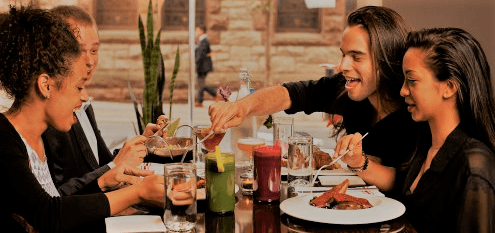Philadelphia's culinary scene offers a richly textured, wonderfully layered dining scene combines history and growth, innovation and tradition, local and global influences.
18 Reasons to Enjoy Philly's Dining Scene
Philadelphia's dining scene has exploded in recent years, offering a diverse and exciting array of culinary experiences. From historic Reading Terminal Market to innovative BYOBs and upscale dining destinations, there's something for every taste and budget. Here are 18 reasons why you should explore Philly's vibrant food scene:
1. Historic Significance:
- City Tavern: Experience 18th-century dining in a recreated colonial tavern.
- Reading Terminal Market: One of the oldest and largest public markets in the US, offering a vast array of food vendors.
2. Diverse Culinary Offerings:
- International Cuisine: Explore flavors from around the world, including Italian, Chinese (in Chinatown), Vietnamese, Mexican, and more.
- BYOB Scene: Enjoy a unique dining experience at numerous BYOB restaurants, allowing you to bring your own wine or beer.
3. Award-Winning Chefs and Restaurants:
- High-Profile Chefs: Philly boasts a growing number of nationally recognized chefs and award-winning restaurants.
- Fine Dining: Indulge in upscale dining experiences with innovative tasting menus and impeccable service.
4. Local and Seasonal Ingredients:
- Farm-to-Table: Many restaurants prioritize locally sourced and seasonal ingredients, showcasing the region's agricultural bounty.
- Fresh Seafood: Enjoy fresh catches from the nearby Jersey Shore at various seafood restaurants.
5. Unique Dining Experiences:
- Food Trucks: Explore the city's diverse food truck scene, offering everything from gourmet sandwiches to international street food.
- Pop-Up Restaurants: Discover unique and temporary dining experiences at various pop-up events.
6. Affordable Options:
- Casual Eateries: Enjoy delicious meals at affordable prices in numerous diners, cafes, and casual restaurants.
- Happy Hour Deals: Take advantage of great deals on food and drinks during happy hour at many bars and restaurants.
7. Craft Beer and Cocktails:
- Breweries and Brewpubs: Explore Philly's thriving craft beer scene at local breweries and brewpubs.
- Cocktail Bars: Indulge in handcrafted cocktails at numerous bars and lounges throughout the city.
8. Coffee Culture:
- Independent Coffee Shops: Enjoy expertly brewed coffee and a cozy atmosphere at numerous independent coffee shops.
- Café Culture: Experience Philly's vibrant café culture, perfect for people-watching and enjoying a leisurely afternoon.
9. Sweet Treats:
- Bakeries and Pastry Shops: Indulge in delicious pastries, cakes, and other sweet treats at various bakeries and pastry shops.
- Ice Cream Parlors: Cool off with delicious ice cream at numerous local ice cream parlors.
10. Outdoor Dining:
- Patios and Gardens: Enjoy al fresco dining at numerous restaurants with outdoor patios and gardens.
- Rooftop Bars: Take in stunning city views while enjoying drinks and food at rooftop bars.
11. Food Festivals and Events:
- Year-Round Events: Participate in various food festivals and events throughout the year, showcasing the city's culinary talent.
- Restaurant Week: Take advantage of special deals and prix fixe menus during Restaurant Week.
12. Diverse Neighborhoods:
- Explore Different Areas: Discover unique culinary experiences in different neighborhoods, each with its own distinct character.
- Ethnic Enclaves: Explore authentic international cuisine in various ethnic enclaves throughout the city.
13. Food Tours:
- Guided Experiences: Take a guided food tour to discover hidden gems and learn about the city's culinary history.
- Neighborhood Tours: Explore specific neighborhoods and their unique culinary offerings through specialized tours.
14. Culinary Education:
- Cooking Classes: Learn new culinary skills at various cooking classes and workshops.
- Chef Demonstrations: Attend chef demonstrations and learn from the city's top culinary professionals.
15. Supporting Local Businesses:
- Independent Restaurants: By dining at local restaurants, you're supporting the city's economy and culinary community.
- Farmers Markets: Shop for fresh, local ingredients at various farmers markets throughout the city.
16. Late-Night Dining:
- 24-Hour Diners: Enjoy late-night meals at classic Philly diners, offering comfort food and a unique atmosphere.
- Late-Night Menus: Many bars and restaurants offer late-night menus for those seeking a late-night bite.
17. Family-Friendly Options:
- Kid-Friendly Restaurants: Find numerous restaurants with kid-friendly menus and atmospheres.
- Casual Dining: Enjoy relaxed dining experiences at various family-friendly establishments.
18. Romantic Dining:
- Intimate Settings: Find numerous restaurants with intimate settings, perfect for a romantic date night.
- Special Occasion Dining: Celebrate special occasions at upscale restaurants with elegant ambiance and impeccable service.
These 18 reasons showcase the depth and breadth of Philadelphia's dining scene, offering something for everyone. Explore the city's culinary landscape and discover your own favorite Philly food experiences!


